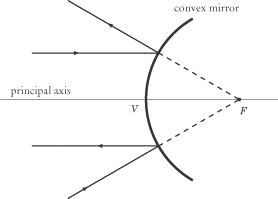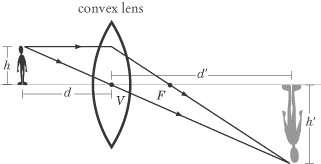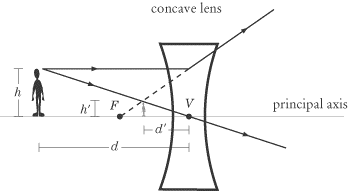The diagram above shows a “ray tracing” image of a concave mirror, showing how a
sample ray of light bounces off it. Though we will take this image as an
example, the same principles and vocabulary apply to convex mirrors and to
lenses as well.
The principal axis of a mirror or lens is a normal that typically runs
through the center of the mirror or lens. The vertex, represented by
V in the diagram, is the point where
the principal axis intersects the mirror or lens.
The only kind of curved mirrors that appear on
Physics are spherical
mirrors, meaning they look like someone sliced off a piece of a sphere.
Spherical mirrors have a center of curvature, represented by
C in the diagram, which is the
center of the sphere of which they are a slice. The radius of that sphere is
called the radius of curvature, R.
All rays of light that run parallel to the principal axis will be reflected—or
refracted in the case of lenses—through the same point, called the focal
point, and denoted by F on the
diagram. Conversely, a ray of light that passes through the focal point will be
reflected parallel to the principal axis. The focal length,
f,
is defined as the distance between the vertex and the focal point.
For spherical mirrors, the focal length is half the radius of curvature,
f = R/2.
Concave Mirrors
Suppose a boy of height h stands at
a distance d in front of a concave mirror. By tracing the light rays that
come from the top of his head, we can see that his reflection would be at a
distance
d'
from the mirror and it would have a height
h'.
As anyone who has looked into a spoon will have guessed, the image appears
upside down.
The image at
d'
is a real image: as we can see from the ray diagram, the image is formed
by actual rays of light. That means that, if you were to hold up a screen at
position
d',
the image of the boy would be projected onto it. You may have noticed the way
that the concave side of a spoon can cast light as you turn it at certain
angles. That’s because concave mirrors project real images.

You’ll notice, though, that we were able to create a real image only by placing
the boy behind the focal point of the mirror. What happens if he stands in front
of the focal point?

The lines of the ray diagram do not converge at any point in front of the
mirror, which means that no real image is formed: a concave mirror can only
project real images of objects that are behind its focal point. However, we can
trace the diverging lines back behind the mirror to determine the position and
size of a virtual image. Like an ordinary flat mirror, the image appears
to be standing behind the mirror, but no light is focused on that point behind
the mirror. With mirrors generally, an image is real if it is in front of the
mirror and virtual if it is behind the mirror. The virtual image is right side
up, at a distance
d'
from the vertex, and stands at a height
h'.
You can test all this yourself with the right kind of spoon. As you hold it at a
distance from your face, you see your reflection upside down. As you slowly
bring it closer, the upside-down reflection becomes blurred and a much larger
reflection of yourself emerges, this time right side up. The image changes from
upside down to right side up as your face crosses the spoon’s focal point.
Convex Mirrors

The focal point of a convex mirror is behind the mirror, so light parallel to
the principal axis is reflected away from the focal point. Similarly, light
moving toward the focal point is reflected parallel to the principal axis. The
result is a virtual, upright image, between the mirror and the focal point.

You’ve experienced the virtual image projected by a convex mirror if you’ve ever
looked into a polished doorknob. Put your face close to the knob and the image
is grotesquely enlarged, but as you draw your face away, the size of the image
diminishes rapidly.
The Two Equations for Mirrors and Lenses
So far we’ve talked about whether images are real or virtual, upright or upside
down. We’ve also talked about images in terms of a focal length
f, distances
d and
d',
and heights h and
h'.
There are two formulas that relate these variables to one another, and that,
when used properly, can tell whether an image is real or virtual, upright or
upside down, without our having to draw any ray diagrams. These two formulas are
all the math you’ll need to know for problems dealing with mirrors and lenses.
First Equation: Focal Length
The first equation relates focal length, distance of an object, and distance of
an image:

Values of d,
d',
and f are positive if they are in
front of the mirror and negative if they are behind the mirror. An object can’t
be reflected unless it’s in front of a mirror, so
d will always be positive. However, as we’ve seen,
f is negative with convex mirrors,
and
d'
is negative with convex mirrors and with concave mirrors where the object is
closer to the mirror than the focal point. A negative value of
d'
signifies a virtual image, while a positive value of
d'
signifies a real image.
Note that a normal, flat mirror is effectively a convex mirror whose focal point
is an infinite distance from the mirror, since the light rays never converge.
Setting 1//f =
0, we get the expected result that the
virtual image is the same distance behind the mirror as the real image is in
front.
Second Equation: Magnification
The second equation tells us about the magnification,
m, of an image:
Values of
h' are positive if the image is upright and negative if the image is upside down.
The value of
m will always be positive because the object itself is
always upright.
The magnification tells us how large the image is with respect to the object: if
 ,
then the image is larger; if
,
then the image is larger; if
 ,
the image is smaller; and if m = 1, as is the case in an ordinary flat
mirror, the image is the same size as the object.
,
the image is smaller; and if m = 1, as is the case in an ordinary flat
mirror, the image is the same size as the object.
Because rays move in straight lines, the closer an image is to the mirror, the
larger that image will appear. Note that
d'/d
will have a positive value with virtual images and a negative value with real
images. Accordingly, the image appears upright with virtual images where
m is positive, and the image appears
upside down with real images where m
is negative.
Example
A woman stands 40 cm from a concave mirror with a focal length of 30 cm. How far
from the mirror should she set up a screen in order for her image to be
projected onto it? If the woman is 1.5 m tall, how tall will her image be on the
screen?
How far from the mirror should she set up a screen in order for her image to be
projected onto it?
The question tells us that d =
40 cm and
f = 30 cm. We can simply plug
these numbers into the first of the two equations and solve for
d',
the distance of the image from the mirror:

Because
d'
is a positive number, we know that the image will be real. Of course, we could
also have inferred this from the fact that the woman sets up a screen onto which
to project the image.
How tall will her image be on the screen?
We know that d =
40 cm, and we now know that
d'
= 120 cm, so we can plug these two values
into the magnification equation and solve for m:
m = -d'/d = -120 cm/40 cm = -3
The image will be three times the height of the woman, or
1.5 × 3 = 4.5
m tall. Because the value of m is
negative, we know that the image will be real, and projected upside down.
Convex Lenses
Lenses behave much like mirrors, except they use the principle of refraction,
not reflection, to manipulate light. You can still apply the two equations
above, but this difference between mirrors and lenses means that the values of
d'
and f for lenses are positive for
distances behind the lens and negative for distances in front of the lens. As
you might expect, d is still always
positive.
Because lenses—both concave and convex—rely on refraction to focus light, the
principle of dispersion tells us that there is a natural limit to how accurately
the lens can focus light. For example, if you design the curvature of a convex
lens so that red light is focused perfectly into the focal point, then violet
light won’t be as accurately focused, since it refracts differently.
A convex lens is typically made of transparent material with a bulge in
the center. Convex lenses are designed to focus light into the focal point.
Because they focus light into a single point, they are sometimes called
“converging” lenses. All the terminology regarding lenses is the same as the
terminology we discussed with regard to mirrors—the lens has a vertex, a
principal axis, a focal point, and so on.

Convex lenses differ from concave mirrors in that their focal point lies on the
opposite side of the lens from the object. However, for a lens, this means that
f > 0,
so the two equations discussed earlier apply to both mirrors and lenses. Note
also that a ray of light that passes through the vertex of a lens passes
straight through without being refracted at an angle.

In this diagram, the boy is standing far enough from the lens that
d > f. As we can see, the image is
real and on the opposite side of the lens, meaning that
d'
is positive. Consequently, the image appears upside down, so
h'
and m are negative. If the boy were
now to step forward so that d < f,
the image would change dramatically:

Now the image is virtual and behind the boy on the same side of the lens,
meaning that
d'
is negative. Consequently, the image appears upright, so
h'
and m are positive.
Concave Lenses

A concave lens is designed to divert light away from the focal point, as
in the diagram. For this reason, it is often called a “diverging” lens. As with
the convex lens, light passing through the vertex does not bend. Note that since
the focal point F is on the same
side of the lens as the object, we say the focal length
f is negative.

As the diagram shows us, and as the two equations for lenses and mirrors will
confirm, the image is virtual, appears on the same side of the lens as the boy
does, and stands upright. This means that
d'
is negative and that
h'
and m are positive. Note that
h >
h',
so m < 1.
Summary
There’s a lot of information to absorb about mirrors and lenses, and remembering
which rules apply to which kinds of mirrors and lenses can be quite difficult.
However, this information is all very systematic, so once you grasp the big
picture, it’s quite easy to sort out the details. In summary, we’ll list three
things that may help you grasp the big picture:
- Learn to draw ray diagrams: Look over the diagrams of the four kinds of
optical instruments and practice drawing them yourself. Remember that light
refracts through lenses and reflects off mirrors. And remember that convex
lenses and concave mirrors focus light to a point, while concave lenses and
convex mirrors cause light to diverge away from a point.
- Memorize the two fundamental equations: You can walk into
Physics
knowing only the two equations for lenses and mirrors and still get a perfect
score on the optical instruments questions, so long as you know how to apply
these equations. Remember that f is
positive for concave mirrors and convex lenses, and negative for convex mirrors
and concave lenses.
- Memorize this table: Because we love you, we’ve put together a handy
table that summarizes everything we’ve covered in this section of the text.
|
Optical Instrument |
Value of d ´ |
Real or virtual? |
Value of f
|
Upright or upside down? |
|
Mirrors (d'and
f are positive in front of mirror) |
Concave d > f
|
+ |
Real |
+ |
Upside down |
|
Concave d < f
|
– |
Virtual |
+ |
Upright |
|
Convex |
– |
Virtual |
– |
Upright |
|
Lenses (d'and
f are positive on far side of lens) |
Convex d > f
|
+ |
Real |
+ |
Upside down |
|
Convex d < f
|
– |
Virtual |
+ |
Upright |
|
Concave |
– |
Virtual |
– |
Upright |
Note that when
d'
is positive, the image is always real and upside down, and when
d'
is negative, the image is always virtual and upright.
Physics questions on optical instruments are generally of two kinds.
Either there will be a quantitative question that will expect you to apply one
of the two equations we’ve learned, or there will be a qualitative question
asking you to determine where light gets focused, whether an image is real or
virtual, upright or upside down, etc.
Back
Next
Next to display next topic in the chapter.
Practice Questions
Video Lessons and 10 Fully Explained Grand Tests
Large number of solved practice MCQ with explanations. Video Lessons and 10 Fully explained Grand/Full Tests.